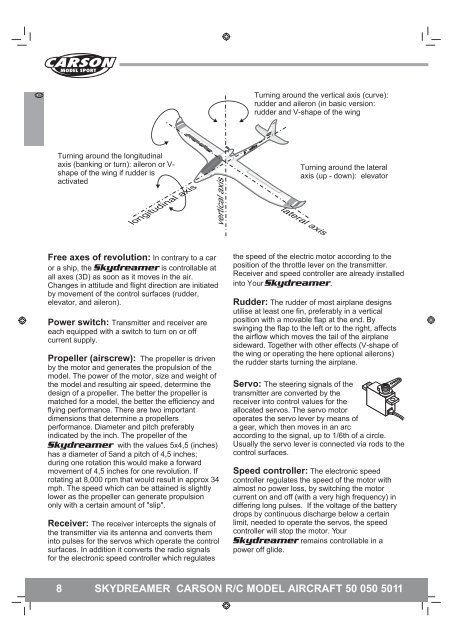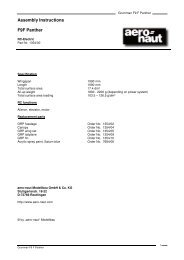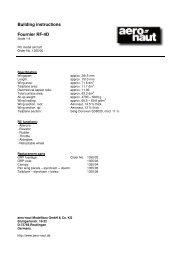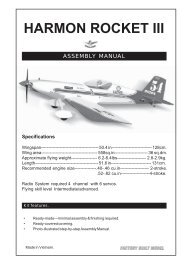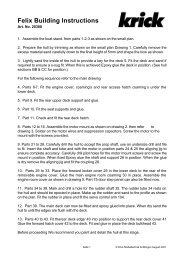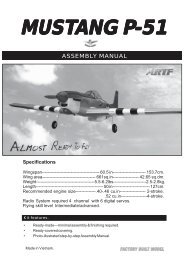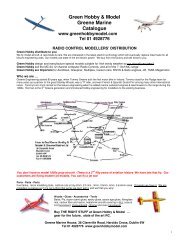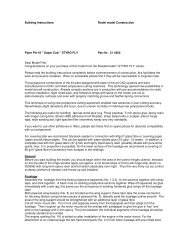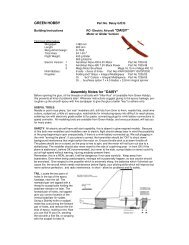Skydreamer - Carson
Skydreamer - Carson
Skydreamer - Carson
You also want an ePaper? Increase the reach of your titles
YUMPU automatically turns print PDFs into web optimized ePapers that Google loves.
GB<br />
Turning around the vertical axis (curve):<br />
rudder and aileron (in basic version:<br />
rudder and V-shape of the wing<br />
Turning around the longitudinal<br />
axis (banking or turn): aileron or V-<br />
shape of the wing if rudder is<br />
activated<br />
longitudinal axis<br />
vertical axis<br />
Turning around the lateral<br />
axis (up - down): elevator<br />
lateral axis<br />
Free axes of revolution: In contrary to a car<br />
or a ship, the <strong>Skydreamer</strong> is controllable at<br />
all axes (3D) as soon as it moves in the air.<br />
Changes in attitude and flight direction are initiated<br />
by movement of the control surfaces (rudder,<br />
elevator, and aileron).<br />
Power switch: Transmitter and receiver are<br />
each equipped with a switch to turn on or off<br />
current supply.<br />
Propeller (airscrew): The propeller is driven<br />
by the motor and generates the propulsion of the<br />
model. The power of the motor, size and weight of<br />
the model and resulting air speed, determine the<br />
design of a propeller. The better the propeller is<br />
matched for a model, the better the efficiency and<br />
flying performance. There are two important<br />
dimensions that determine a propellers<br />
performance. Diameter and pitch preferably<br />
indicated by the inch. The propeller of the<br />
<strong>Skydreamer</strong> with the values 5x4,5 (inches)<br />
has a diameter of 5and a pitch of 4,5 inches;<br />
during one rotation this would make a forward<br />
movement of 4,5 inches for one revolution. If<br />
rotating at 8,000 rpm that would result in approx 34<br />
mph. The speed which can be attained is slightly<br />
lower as the propeller can generate propulsion<br />
only with a certain amount of "slip".<br />
Receiver: The receiver intercepts the signals of<br />
the transmitter via its antenna and converts them<br />
into pulses for the servos which operate the control<br />
surfaces. In addition it converts the radio signals<br />
for the electronic speed controller which regulates<br />
the speed of the electric motor according to the<br />
position of the throttle lever on the transmitter.<br />
Receiver and speed controller are already installed<br />
into Your <strong>Skydreamer</strong>.<br />
Rudder: The rudder of most airplane designs<br />
utilise at least one fin, preferably in a vertical<br />
position with a movable flap at the end. By<br />
swinging the flap to the left or to the right, affects<br />
the airflow which moves the tail of the airplane<br />
sideward. Together with other effects (V-shape of<br />
the wing or operating the here optional ailerons)<br />
the rudder starts turning the airplane.<br />
Servo: The steering signals of the<br />
transmitter are converted by the<br />
receiver into control values for the<br />
allocated servos. The servo motor<br />
operates the servo lever by means of<br />
a gear, which then moves in an arc<br />
according to the signal, up to 1/6th of a circle.<br />
Usually the servo lever is connected via rods to the<br />
control surfaces.<br />
Speed controller: The electronic speed<br />
controller regulates the speed of the motor with<br />
almost no power loss, by switching the motor<br />
current on and off (with a very high frequency) in<br />
differing long pulses. If the voltage of the battery<br />
drops by continuous discharge below a certain<br />
limit, needed to operate the servos, the speed<br />
controller will stop the motor. Your<br />
<strong>Skydreamer</strong> remains controllable in a<br />
power off glide.<br />
8 SKYDREAMER CARSON R/C MODEL AIRCRAFT 50 050 5011


